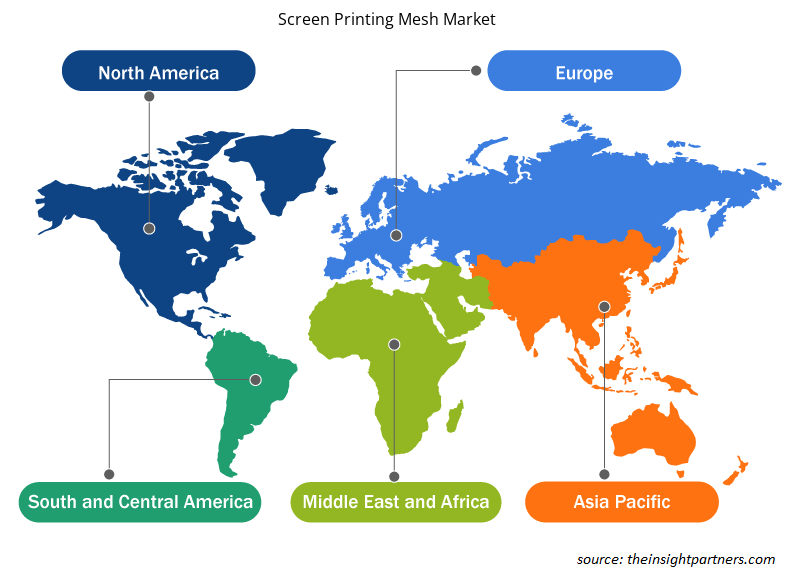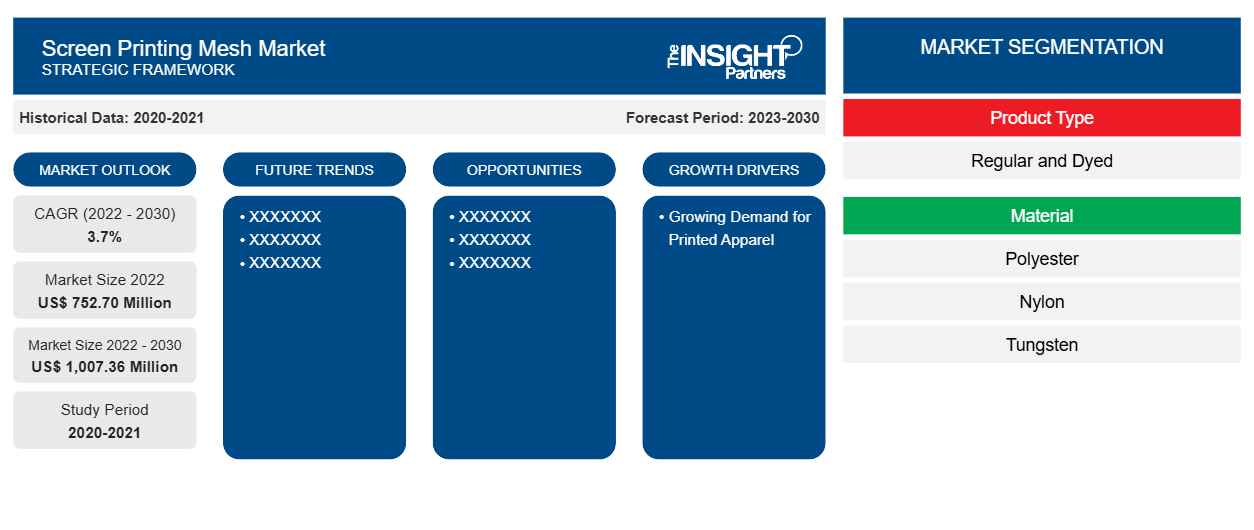[研究报告] 丝网印刷网布市场规模预计将从 2022 年的 7.527 亿美元增长到 2030 年的 10.0736 亿美元;预计 2022 年至 2030 年的复合年增长率为 3.7%。
市场洞察和分析师观点:
丝网印刷网是指在框架上紧紧拉伸以形成丝网印刷网的编织织物或材料。丝网印刷网有不同的目数。不同目数的丝网印刷网在丝网印刷过程中具有特定的优势。它们由尼龙、聚酯、不锈钢、钨等材料制成。聚酯丝网印刷网因其出色的多功能性和耐用性而成为广泛使用的材料。丝网印刷网用于纺织、电子电气、玻璃、陶瓷和许多其他行业。在电子电气行业,丝网印刷网用于在各种基材上印刷,例如电路板、太阳能电池板、柔性电路和显示器。消费者寻求能够反映其个人风格的独特和个性化物品,对个性化和定制服装的需求日益增长。这一因素极大地推动了全球丝网印刷网市场的增长。
增长动力和挑战:
印花服装的流行趋势推动了服装行业对丝网印刷网布的需求。近年来,印花服装的流行趋势日益增长,消费者寻求能够反映其风格的独特个性化产品。这一趋势推动了服装行业对丝网印刷网布的需求,因为它可以将定制设计以高质量和精确的方式印刷到各种面料和材料上。此外,随着企业寻求具有成本效益的方式来推广其品牌,促销产品也变得越来越受欢迎。丝网印刷网布是制作高质量和引人注目的促销品的关键组成部分。许多企业和组织使用定制印刷品(例如 T 恤、包和帽子)来宣传其品牌或信息。丝网印刷网布可以高质量且具有成本效益地批量印刷这些促销产品。随着越来越多的公司将促销产品作为营销策略,对丝网印刷网布的需求将继续增加。然而,尽管丝网印刷网布市场具有增长潜力,但印刷行业的技术进步可能会对其进一步扩张构成挑战。随着数字印刷技术的不断进步,它们为许多应用提供了可行的丝网印刷网布替代品。数字印刷可以缩短周转时间,提高设计灵活性,并能够在更广泛的材料上进行印刷。这一因素阻碍了对丝网印刷网布的需求。
定制此报告以满足您的需求
您可以免费定制任何报告,包括本报告的部分内容、国家级分析、Excel 数据包,以及为初创企业和大学提供优惠和折扣
- 获取此报告的关键市场趋势。这个免费样品将包括数据分析,从市场趋势到估计和预测。
报告细分和范围:
“全球丝网印刷网布市场”根据产品类型、材料和应用进行细分。根据产品类型,丝网印刷网布市场分为常规和染色。根据材料,丝网印刷网布市场分为聚酯、尼龙、钨、不锈钢等。根据应用,丝网印刷网布市场分为纺织品、电子和电气、玻璃和陶瓷等。从地理上讲,市场分为北美(美国、加拿大和墨西哥)、欧洲(德国、法国、意大利、英国、俄罗斯和欧洲其他地区)、亚太地区(澳大利亚、中国、日本、印度、韩国和亚太地区其他地区)、中东和非洲(南非、沙特阿拉伯、阿联酋和中东和非洲其他地区)以及南美洲和中美洲(巴西、阿根廷和南美洲和中美洲其他地区)。electricals, glass and ceramics, and others. Geographically, the market is segmented into North America (the US, Canada, and Mexico), Europe (Germany, France, Italy, the UK, Russia, and the Rest of Europe), Asia Pacific (Australia, China, Japan, India, South Korea, and the Rest of Asia Pacific), the Middle East & Africa (South Africa, Saudi Arabia, the UAE, and the Rest of Middle East & Africa), and South & Central America (Brazil, Argentina, and the Rest of South & Central America).
节段分析: Analysis:
根据产品类型,丝网印刷网市场分为常规和染色。常规部分在 2022 年占有较大的市场份额。常规丝网印刷网是印刷和纺织生产中一个基本且经常被低估的组成部分。由聚酯和尼龙等优质材料制成的印刷网可作为低调的画布,在其上表达复杂的设计和图案。它的重要性在于它能够充当空白板,确保最终印刷的颜色和细节与原始艺术品保持一致。根据材料,丝网印刷网市场分为聚酯、尼龙、 钨、不锈钢等。2022 年聚酯部分的丝网印刷网市场份额引人注目。聚酯丝网印刷网是丝网印刷中一种重要且广泛使用的材料,因其出色的多功能性和耐用性而受到赞赏。聚酯是一种合成聚合物,是这种网的基础,其固有特性使其成为广泛印刷应用的理想选择。聚酯丝网印刷网的突出特点之一是其强度和弹性。根据应用,丝网印刷网布市场细分为纺织品、电子电气、玻璃和陶瓷等。2022 年,纺织品领域的丝网印刷网布市场份额显著。丝网印刷网布已成为纺织行业必不可少的工具,具有一系列优势,是将图案印刷到织物上的理想选择。丝网印刷网布由耐用且柔韧的优质材料制成,可以在框架上拉伸而不会失去形状或完整性。这使得创建光滑均匀的印刷表面变得容易,确保准确捕捉每个设计细节。丝网印刷网布的主要优势之一是它能够产生精确而细致的设计,即使在复杂的图案或织物上也是如此。
区域分析:
丝网印刷网布市场分为五个主要区域——北美、欧洲、亚太、南美和中美以及中东和非洲。亚太地区在全球丝网印刷网布市场中占据主导地位,2022 年该地区市场规模约为 3 亿美元。北美也是一个主要贡献者,占据了全球丝网印刷网布市场份额的很大一部分。预计到 2030 年,北美市场规模将超过 2.5 亿美元。预计 2022 年至 2030 年期间,欧洲的复合年增长率将超过 3%。按国家/地区划分,亚太丝网印刷网布市场分为澳大利亚、中国、印度、日本、韩国和亚太其他地区。市场受到印花服装需求不断增长和促销产品日益普及等因素的驱动。亚太地区对丝网印刷网布的需求与该地区的工业化和纺织品生产增长有关。根据 2030 年可持续发展目标,亚洲开发银行计划在亚太地区建设弹性基础设施,促进包容性和可持续的工业化,并促进创新。亚太地区是纺织业的主要枢纽。亚太地区包括中国、印度和孟加拉国等主要纺织品生产国。中国、印度、越南和孟加拉国等国家纺织品制造商数量的增加进一步刺激了对丝网印刷网布的需求。
行业发展和未来机遇:
以下列出了丝网印刷网市场主要参与者采取的各种举措:
- 2022 年 3 月,Sefar 扩大了其 SEFAR PME 丝网印刷网布系列。这些新网布在 FESPA 2022 上展出。新的 Sefar Open Mesh 网布为 SEFAR PME 59/150-48Y PW 和 SEFAR PME 75/190-40W/Y PW。
COVID-19 影响:
COVID-19 疫情影响了各国几乎所有行业。北美、欧洲、亚太地区 (APAC)、南美和中美 (SAM) 以及中东和非洲 (MEA) 的封锁、旅行限制和企业停工阻碍了多个行业的增长,包括化学品和材料行业。制造部门的关闭扰乱了全球供应链、制造活动、交付时间表以及必需品和非必需品销售。多家公司报告称,2020 年产品交付延迟,产品销售下滑。由于疫情引发的经济衰退,消费者在购买决策方面变得谨慎和挑剔。由于收入较低和收入前景不确定,消费者大幅减少了非必需品购买,尤其是在发展中地区。由于疫情初期消费者需求减少,许多丝网印刷网制造商面临利润下降的问题。然而,到 2021 年底,许多国家都已全面接种疫苗,政府宣布放宽某些规定,包括封锁和旅行禁令。人们开始前往不同的地方,这增加了对丝网印刷网的需求。所有这些因素都对不同地区的丝网印刷网市场的增长产生了积极影响。
丝网印刷网布市场区域洞察
Insight Partners 的分析师已详尽解释了预测期内影响丝网印刷网布市场的区域趋势和因素。本节还讨论了北美、欧洲、亚太地区、中东和非洲以及南美和中美洲的丝网印刷网布市场细分和地理位置。

- 获取丝网印刷网布市场的区域特定数据
丝网印刷网布市场报告范围
| 报告属性 | 细节 |
|---|---|
| 2022 年市场规模 | 7.527亿美元 |
| 2030 年的市场规模 | 10.0736亿美元 |
| 全球复合年增长率(2022 - 2030 年) | 3.7% |
| 史料 | 2020-2021 |
| 预测期 | 2023-2030 |
| 涵盖的领域 | 按产品类型
|
| 覆盖地区和国家 | 北美
|
| 市场领导者和主要公司简介 |
|
市场参与者密度:了解其对商业动态的影响
丝网印刷网布市场正在快速增长,这得益于终端用户需求的不断增长,而这些需求又源于消费者偏好的不断变化、技术进步以及对产品优势的认识不断提高等因素。随着需求的增加,企业正在扩大其产品范围,进行创新以满足消费者的需求,并利用新兴趋势,从而进一步推动市场增长。
市场参与者密度是指在特定市场或行业内运营的企业或公司的分布情况。它表明相对于给定市场空间的规模或总市场价值,有多少竞争对手(市场参与者)存在于该市场空间中。
在丝网印刷网布市场运营的主要公司有:
- NBC 网格技术
- 浅田网
- 日本特殊织物
- 河北安平印刷网版有限公司
- 青岛长城实业有限公司
免责声明:上面列出的公司没有按照任何特定顺序排列。

- 获取丝网印刷网布市场主要参与者概览
竞争格局和重点公司:
NBC Meshtec;Asada Mesh;Nippon Tokushu Fabric;河北安平印刷网业有限公司;青岛长城工业有限公司;上海金上丝网印刷设备有限公司;Sefar AG;Saati SPA;HAVER & BOECKER OHG;以及 Weisse & Eschrich GmbH & Co. KG. 是全球丝网印刷网市场的主要参与者。这些参与者提供高质量的丝网印刷网,满足全球市场上众多消费者的需求。
- 历史分析(2 年)、基准年、预测(7 年)及复合年增长率
- PEST 和 SWOT 分析
- 市场规模价值/数量 - 全球、区域、国家
- 行业和竞争格局
- Excel 数据集


- Machine Condition Monitoring Market
- Advanced Planning and Scheduling Software Market
- Occupational Health Market
- Battery Testing Equipment Market
- Online Recruitment Market
- Adaptive Traffic Control System Market
- Semiconductor Metrology and Inspection Market
- Smart Grid Sensors Market
- Artwork Management Software Market
- Hand Sanitizer Market

Report Coverage
Revenue forecast, Company Analysis, Industry landscape, Growth factors, and Trends

Segment Covered
This text is related
to segments covered.

Regional Scope
North America, Europe, Asia Pacific, Middle East & Africa, South & Central America

Country Scope
This text is related
to country scope.
常见问题
The major players operating in the global screen printing mesh market are NBC Meshtec; Asada Mesh; Nippon Tokushu Fabric; HEBEI ANPING PRINTING SCREEN CO., LTD; QINGDAO GREATWALL INDUSTRY CO., LTD; Shanghai Gold-Up Screen Printing Facilities Co. Ltd.; Sefar AG; Saati SPA; HAVER & BOECKER OHG; and Weisse & Eschrich GmbH & Co. KG.`
Screen printing has emerged as a crucial technology in the production of solar panels, and its demand has been steadily growing in recent years. This trend is primarily driven by its cost-effectiveness and efficiency in manufacturing photovoltaic cells. Screen printing allows for the precise application of conductive materials, such as silver paste, onto solar cell surfaces, enabling the creation of electrical pathways. This method's popularity has surged due to its ability to produce high-quality solar panels at a lower cost, making renewable energy more accessible to a broader audience.
Asia Pacific accounted for the largest share of the global screen printing mesh market. Asia Pacific is one of the most significant regions for the screen printing mesh market owing to drastic increase in the demand for printed apparel.
Based on material, the screen printing mesh market is segmented into polyester, nylon, tungsten, stainless steel, and others. The screen printing mesh market share for the polyester segment was notable in 2022. Polyester screen printing mesh is a vital and widely used material in screen printing, appreciated for its exceptional versatility and durability. Polyester, a synthetic polymer, serves as the foundation for this mesh, and its inherent qualities make it an ideal choice for a wide range of printing applications. One of the standout characteristics of polyester screen printing mesh is its strength and resilience.
The increasing trend of printed clothing is driving the demand for screen printing mesh in the apparel industry. In recent years, there has been a growing trend toward printed clothing, with consumers seeking unique and individualized items that reflect their style. This trend has propelled the demand for screen printing mesh in the apparel industry, as it allows for high-quality and precise printing of custom designs onto a wide range of fabrics and materials. Screen printing mesh is particularly popular for creating t-shirts, hoodies, and other garments with custom graphics or logos.
Based on product type, the screen printing mesh market is segmented into regular and dyed. The regular segment held a larger market share in 2022. Regular screen printing mesh is a fundamental and often underestimated component in printing and textile production. Printing mesh crafted from premium materials such as polyester and nylon serves as the unassuming canvas upon which intricate designs and patterns are expressed. Its significance lies in its ability to act as a blank slate, ensuring that the colors and details of the final print remain true to the original artwork.
Trends and growth analysis reports related to Consumer Goods : READ MORE..
The List of Companies - Screen Printing Mesh Market
- NBC Meshtec
- Asada Mesh
- Nippon Tokushu Fabric
- HEBEI ANPING PRINTING SCREEN CO., LTD
- QINGDAO GREATWALL INDUSTRY CO., LTD
- Shanghai Gold-Up Screen Printing Facilities Co. Ltd.
- Sefar AG
- Saati SPA
- HAVER & BOECKER OHG
- Weisse & Eschrich GmbH & Co. KG
The Insight Partners performs research in 4 major stages: Data Collection & Secondary Research, Primary Research, Data Analysis and Data Triangulation & Final Review.
- Data Collection and Secondary Research:
As a market research and consulting firm operating from a decade, we have published and advised several client across the globe. First step for any study will start with an assessment of currently available data and insights from existing reports. Further, historical and current market information is collected from Investor Presentations, Annual Reports, SEC Filings, etc., and other information related to company’s performance and market positioning are gathered from Paid Databases (Factiva, Hoovers, and Reuters) and various other publications available in public domain.
Several associations trade associates, technical forums, institutes, societies and organization are accessed to gain technical as well as market related insights through their publications such as research papers, blogs and press releases related to the studies are referred to get cues about the market. Further, white papers, journals, magazines, and other news articles published in last 3 years are scrutinized and analyzed to understand the current market trends.
- Primary Research:
The primarily interview analysis comprise of data obtained from industry participants interview and answers to survey questions gathered by in-house primary team.
For primary research, interviews are conducted with industry experts/CEOs/Marketing Managers/VPs/Subject Matter Experts from both demand and supply side to get a 360-degree view of the market. The primary team conducts several interviews based on the complexity of the markets to understand the various market trends and dynamics which makes research more credible and precise.
A typical research interview fulfils the following functions:
- Provides first-hand information on the market size, market trends, growth trends, competitive landscape, and outlook
- Validates and strengthens in-house secondary research findings
- Develops the analysis team’s expertise and market understanding
Primary research involves email interactions and telephone interviews for each market, category, segment, and sub-segment across geographies. The participants who typically take part in such a process include, but are not limited to:
- Industry participants: VPs, business development managers, market intelligence managers and national sales managers
- Outside experts: Valuation experts, research analysts and key opinion leaders specializing in the electronics and semiconductor industry.
Below is the breakup of our primary respondents by company, designation, and region:

Once we receive the confirmation from primary research sources or primary respondents, we finalize the base year market estimation and forecast the data as per the macroeconomic and microeconomic factors assessed during data collection.
- Data Analysis:
Once data is validated through both secondary as well as primary respondents, we finalize the market estimations by hypothesis formulation and factor analysis at regional and country level.
- Macro-Economic Factor Analysis:
We analyse macroeconomic indicators such the gross domestic product (GDP), increase in the demand for goods and services across industries, technological advancement, regional economic growth, governmental policies, the influence of COVID-19, PEST analysis, and other aspects. This analysis aids in setting benchmarks for various nations/regions and approximating market splits. Additionally, the general trend of the aforementioned components aid in determining the market's development possibilities.
- Country Level Data:
Various factors that are especially aligned to the country are taken into account to determine the market size for a certain area and country, including the presence of vendors, such as headquarters and offices, the country's GDP, demand patterns, and industry growth. To comprehend the market dynamics for the nation, a number of growth variables, inhibitors, application areas, and current market trends are researched. The aforementioned elements aid in determining the country's overall market's growth potential.
- Company Profile:
The “Table of Contents” is formulated by listing and analyzing more than 25 - 30 companies operating in the market ecosystem across geographies. However, we profile only 10 companies as a standard practice in our syndicate reports. These 10 companies comprise leading, emerging, and regional players. Nonetheless, our analysis is not restricted to the 10 listed companies, we also analyze other companies present in the market to develop a holistic view and understand the prevailing trends. The “Company Profiles” section in the report covers key facts, business description, products & services, financial information, SWOT analysis, and key developments. The financial information presented is extracted from the annual reports and official documents of the publicly listed companies. Upon collecting the information for the sections of respective companies, we verify them via various primary sources and then compile the data in respective company profiles. The company level information helps us in deriving the base number as well as in forecasting the market size.
- Developing Base Number:
Aggregation of sales statistics (2020-2022) and macro-economic factor, and other secondary and primary research insights are utilized to arrive at base number and related market shares for 2022. The data gaps are identified in this step and relevant market data is analyzed, collected from paid primary interviews or databases. On finalizing the base year market size, forecasts are developed on the basis of macro-economic, industry and market growth factors and company level analysis.
- Data Triangulation and Final Review:
The market findings and base year market size calculations are validated from supply as well as demand side. Demand side validations are based on macro-economic factor analysis and benchmarks for respective regions and countries. In case of supply side validations, revenues of major companies are estimated (in case not available) based on industry benchmark, approximate number of employees, product portfolio, and primary interviews revenues are gathered. Further revenue from target product/service segment is assessed to avoid overshooting of market statistics. In case of heavy deviations between supply and demand side values, all thes steps are repeated to achieve synchronization.
We follow an iterative model, wherein we share our research findings with Subject Matter Experts (SME’s) and Key Opinion Leaders (KOLs) until consensus view of the market is not formulated – this model negates any drastic deviation in the opinions of experts. Only validated and universally acceptable research findings are quoted in our reports.
We have important check points that we use to validate our research findings – which we call – data triangulation, where we validate the information, we generate from secondary sources with primary interviews and then we re-validate with our internal data bases and Subject matter experts. This comprehensive model enables us to deliver high quality, reliable data in shortest possible time.


 获取此报告的免费样本
获取此报告的免费样本